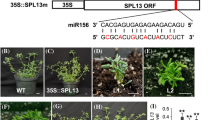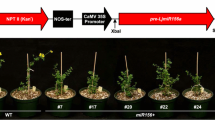Abstract
Successful reproduction of the plants is considered as a critical challenge in meeting the nutritional needs of the growing world population. A major significant change in the plant's life cycle is the transition from vegetative to reproductive phase. The flowering and bolting processes are influenced by several genetic and physiological factors. Molecular and genetic studies have identified key factors in age-dependent gene regulatory pathways such as miR172-miR156-SPLs module in phase transition in plants. Unlike in model plants, the role of miR172-miR156-SPLs like regulatory networks remains unexplored in crops such as Beta vulgaris. In the present study, for the first time, miR156 from Beta vulgaris was identified and characterized. miR156 gene from Beta vulgaris was cloned and ectopically overexpressed under the control of strong 35S promoter in sugar beet explants. Subsequently, transcript levels of the miR156 and its known targets (SPL4 and SPL9) were quantified in the transgenic and control plants. Consistent with reported role of mir156 in downregulation of SPL4 and SPL9, miR156 overexpression plants exhibited delayed flowering and atypical rooting pattern indicative of abnormal root development and poor root foraging performance. Altogether, our results suggest that Beta vulgaris miR156 modulate phase transition by acting as negative regulator of SPL4 and SPL9.
Key message
The research confirmed that the overexpression of miR156 has an effective role in the reduction of SPL4 and SPL9 gene expression, and eventually results in beet flowering suppression.







Similar content being viewed by others
Data availability
The datasets generated during and/or analyzed through the current study will be available from the corresponding author upon reasonable request.
References
Ambros V (2004) The functions of animal microRNAs. Nature 431:350–355
Aukerman MJ, Sakai H (2003) Regulation of flowering time and floral organ identity by a MicroRNA and its APETALA2-like target genes. Plant Cell Online 15:2730–2741. https://doi.org/10.1105/tpc.016238
Aung B, Abdelali Hannoufa S (2014) Effects of microRNA156 on flowering time and plant architecture in Medicago sativa. Electronic Thesis and Dissertation Repository 1956. https://ir.lib.uwo.ca/etd/1956. Accessed 23 Apr 2014
Aung B, Gruber MY, Hannoufa A (2015) The MicroRNA156 system: a tool in plant biotechnology. Biocatal Agric Biotechnol 4:432–442. https://doi.org/10.1016/j.bcab.2015.08.002
Bartel DP, Chen CZ (2004) Micromanagers of gene expression: the potentially widespread influence of metazoan microRNAs. Nat Rev Genet 5:396–400. https://doi.org/10.1038/nrg1328
Biancardi E, Campbell LG, Skaracis GN, De Biaggi M (2005) Genetics and breeding of sugar beet. Science. https://doi.org/10.1201/9781482280296
Chia TYP, Müller A, Jung C, Mutasa-Göttgens ES (2008) Sugar beet contains a large CONSTANS-LIKE gene family including a CO homologue that is independent of the early-bolting (B) gene locus. J Exp Bot 59:2735–2748. https://doi.org/10.1093/jxb/ern129
Cho SH, Coruh C, Axtell MJ (2012) miR156 and miR390 regulate tasiRNA accumulation and developmental timing in Physcomitrella patens. Plant Cell 24:4837–4849. https://doi.org/10.1105/tpc.112.103176
Dohm JC, Minoche AE, Holtgrawe D et al (2014) The genome of the recently domesticated crop plant sugar beet (Beta vulgaris). Nature 505:546–549
El-Mezawy A, Dreyer F, Jacobs G, Jung C (2002) High-resolution mapping of the bolting gene B of sugar beet. Theor Appl Genet 105:100–105. https://doi.org/10.1007/s00122-001-0859-z
Gandikota M, Birkenbihl RP, Hhmann S et al (2007) The miRNA156/157 recognition element in the 3’ UTR of the Arabidopsis SBP box gene SPL3 prevents early flowering by translational inhibition in seedlings. Plant J 49:683–693. https://doi.org/10.1111/j.1365-313X.2006.02983.x
Gao R, Austin RS, Amyot L, Hannoufa A (2016) Comparative transcriptome investigation of global gene expression changes caused by miR156 overexpression in Medicago sativa. BMC Genom 17:658. https://doi.org/10.1186/s12864-016-3014-6
Hébrard C, Peterson DG, Willems G et al (2016) Epigenomics and bolting tolerance in sugar beet genotypes. J Exp Bot 67:207–225. https://doi.org/10.1093/jxb/erv449
Huijser P, Schmid M (2011) The control of developmental phase transitions in plants. Development 138:4117–4129. https://doi.org/10.1242/dev.063511
Jaggard KW, Qi A, Ober ES (2009) Capture and use of solar radiation, water, and nitrogen by sugar beet (Beta vulgaris L.). J Exp Bot 60:1919–1925. https://doi.org/10.1093/jxb/erp110
Jiang F, Guo M, Yang F et al (2012) Mutations in an AP2 transcription factor-like gene affect internode length and leaf shape in maize. PLoS ONE 7:e37040. https://doi.org/10.1371/journal.pone.0037040
Jung JH, Seo PJ, Kang SK, Park CM (2011) miR172 signals are incorporated into the miR156 signaling pathway at the SPL3/4/5 genes in Arabidopsis developmental transitions. Plant Mol Biol 76:35–45. https://doi.org/10.1007/s11103-011-9759-z
Kim JJ, Lee JH, Kim W et al (2012) The microRNA156-squamosa promoter binding protein-LIKE3 module regulates ambient temperature-responsive flowering via Flowering locus T in Arabidopsis. Plant Physiol 159:461–478. https://doi.org/10.1104/pp.111.192369
Kobayashi Y, Weigel D (2007) Move on up, it’s time for change—mobile signals controlling photoperiod-dependent flowering. Genes Dev 21:2371–2384. https://doi.org/10.1101/gad.1589007
Lau NC, Lim LP, Weinstein EG, Bartel DP (2001) An abundant class of tiny RNAs with probable regulatory roles in Caenorhabditis elegans. Science 294:858–862. https://doi.org/10.1126/science.1065062
Llave C (2002) Endogenous and silencing-associated small RNAs in plants. Plant Cell Online 14:1605–1619. https://doi.org/10.1105/tpc.003210
Michaels SD, Amasino RM (2001) Loss of flowering locus C activity eliminates the late-flowering phenotype of FRIGIDA and autonomous pathway mutations but not responsiveness to vernalization. Plant Cell 13:935–941. https://doi.org/10.1105/tpc.13.4.935
Mirzaie-Asl A, Moieni A, Salmanian AH et al (2010) Effects of hormonal pretreatments and genotype on invitro induction of direct adventitious shoots on Sugar Beet (Beta vulgaris L.) leaves. Iran J Biol 22:719–729 (in persian)
Mutasa-Gottgens E, Qi A, Mathews A et al (2009) Modification of gibberellin signalling (metabolism & signal transduction) in sugar beet: analysis of potential targets for crop improvement. Transgenic Res 18:301–308. https://doi.org/10.1007/s11248-008-9211-6
Mutasa-Gottgens E, Qi A, Zhang W et al (2010) Bolting and flowering control in sugar beet: relationships and effects of gibberellin, the bolting gene B and vernalization. AoB Plants 2010:1–13. https://doi.org/10.1093/aobpla/plq012
Pfeiffer N, Tränkner C, Lemnian I et al (2014) Genetic analysis of bolting after winter in sugar beet (Beta vulgaris L.). Theor Appl Genet 127:2479–2489. https://doi.org/10.1007/s00122-014-2392-x
Reeves PA, He Y, Schmitz RJ et al (2007) Evolutionary conservation of the flowering locus C-mediated vernalization response: evidence from the sugar beet (Beta vulgaris). Genetics 176:295–307. https://doi.org/10.1534/genetics.106.069336
Reinhart BJ, Weinstein EG, Rhoades MW et al (2002) MicroRNAs in plants. Genes Dev 16:1616–1626. https://doi.org/10.1101/gad.1004402
Sambrook J, Russell DW (2001) Molecular cloning: a laboratory manual. Cold Spring Harbor Laboratory Press, New York
Schwarz S, Grande AV, Bujdoso N et al (2008) The microRNA regulated SBP-box genes SPL9 and SPL15 control shoot maturation in Arabidopsis. Plant Mol Biol 67:183–195. https://doi.org/10.1007/s11103-008-9310-z
Simpson GG (2004) The autonomous pathway: Epigenetic and post-transcriptional gene regulation in the control of Arabidopsis flowering time. Curr Opin Plant Biol 7:570–574. https://doi.org/10.1016/j.pbi.2004.07.002
Sun G (2012) MicroRNAs and their diverse functions in plants. Plant Mol Biol 80:17–36. https://doi.org/10.1007/s11103-011-9817-6
Sung S, Amasino RM (2004) Vernalization in Arabidopsis thaliana is mediated by the PHD finger protein VIN3. Nature 427:159–164. https://doi.org/10.1038/nature02195
Van Roggen, PM, Gielen JJL, Pin P, et al (2009) Engineering of bolting resistance in sugar beet by means of the transgenic expression of the beet homologue of flowering time control gene FT. Patent Cooperation Treaty. https://patents.google.com/patent/WO2010025888A2/en. Accessed 11 Mar 2010.
Voinnet O (2009) Origin, biogenesis, and activity of plant MicroRNAs. Cell 136:669–687. https://doi.org/10.1016/j.cell.2009.01.046
Wang JW, Czech B, Weigel D (2009) miR156-regulated SPL transcription factors define an endogenous flowering pathway in Arabidopsis thaliana. Cell 138:738–749. https://doi.org/10.1016/j.cell.2009.06.014
Wang J, Huang SK, Zhao M et al (2014) Identification of a circulating microRNA signature for colorectal cancer detection. PLoS ONE 9:e87451. https://doi.org/10.1371/journal.pone.0087451
Wang Y, Wang Z, Amyot L et al (2015) Ectopic expression of miR156 represses nodulation and causes morphological and developmental changes in Lotus japonicus. Mol Genet Genomics 290:471–484. https://doi.org/10.1007/s00438-014-0931-4
Wei S, Gruber MY, Yu B et al (2012) Arabidopsis mutant sk156 reveals complex regulation of SPL15 in a miR156-controlled gene network. BMC Plant Biol 12:169. https://doi.org/10.1186/1471-2229-12-169
Wigge PA, Kim MC, Jaeger KE et al (2005) Integration of spatial and temporal information during floral induction in Arabidopsis. Science 309:1056–1059. https://doi.org/10.1126/science.1114358
Wu X, Liu T (2009) Spectral decomposition of seismic data with reassigned smoothed pseudo Wigner–Ville distribution. J Appl Geophys 68:386–393. https://doi.org/10.1016/j.jappgeo.2009.03.004
Wu G, Poethig R (2006) Temporal regulation of shoot development in Arabidopsis thaliana by miR156 and its target SPL3. Development 133:3539–3547. https://doi.org/10.1242/dev.02521
Wu G, Park MY, Conway SR et al (2009) The sequential action of miR156 and miR172 regulates developmental timing in Arabidopsis. Cell 138:750–759. https://doi.org/10.1016/j.cell.2009.06.031
Xie K, Shen J, Hou X et al (2012) Gradual increase of miR156 regulates temporal expression changes of numerous genes during leaf development in rice. Plant Physiol 158:1382–1394. https://doi.org/10.1104/pp.111.190488
Yamaguchi A, Wu M, Yang L et al (2009) Article the microRNA-regulated SBP-box transcription factor SPL3 is a direct upstream activator. Dev Cell 17:268–278. https://doi.org/10.1016/j.devcel.2009.06.007
Yant L, Mathieu J, Dinh TT et al (2010) Orchestration of the floral transition and floral development in Arabidopsis by the bifunctional transcription factor APETALA2. Plant Cell Online 22:2156–2170. https://doi.org/10.1105/tpc.110.075606
Zhang BH, Pan XP, Wang QL et al (2005) Identification and characterization of new plant microRNAs using EST analysis. Cell Res 15:336–360
Zhang B, Pan X, Cobb GP, Anderson TA (2006) Plant microRNA: a small regulatory molecule with big impact. Dev Biol 289:3–16. https://doi.org/10.1016/j.ydbio.2005.10.036
Zhou M, Luo H (2013) MicroRNA-mediated gene regulation: potential applications for plant genetic engineering. Plant Mol Biol 83:59–75. https://doi.org/10.1007/s11103-013-0089-1
Zhou B, Fan P, Li Y et al (2016) Exploring miRNAs involved in blue/UV-A light response in Brassica rapa reveals special regulatory mode during seedling development. BMC Plant Biol 16:111. https://doi.org/10.1186/s12870-016-0799-z
Acknowledgements
The authors would like to appreciate all supports offered by Bu-Ali Sina University, Hamedan, Iran.
Funding
The research was funded by Bu-Ali Sina University, Hamedan, Iran.
Author information
Authors and Affiliations
Contributions
MA and AM have designed the research. MA has conducted the experiment. All authors had contributed to data analysis. MA and AM have written the manuscript. All authors have read and approved the manuscript.
Corresponding author
Ethics declarations
Conflict of interest
The financial supports of this research were provided by Bu-Ali Sina University budgets.
Consent to participate
All authors are consented to participate in the research.
Consent for publication
All authors are consented for publication of the research.
Additional information
Communicated by Francisco de Assis Alves Mourão Filho.
Publisher's Note
Springer Nature remains neutral with regard to jurisdictional claims in published maps and institutional affiliations.
Supplementary Information
Below is the link to the electronic supplementary material.
Rights and permissions
About this article
Cite this article
Asgari, M., Mirzaie-asl, A., Abdollahi, M.R. et al. Flowering time regulation by the miRNA156 in the beet (Beta vulgaris ssp. maritima). Plant Cell Tiss Organ Cult 150, 361–370 (2022). https://doi.org/10.1007/s11240-022-02285-6
Received:
Accepted:
Published:
Issue Date:
DOI: https://doi.org/10.1007/s11240-022-02285-6




